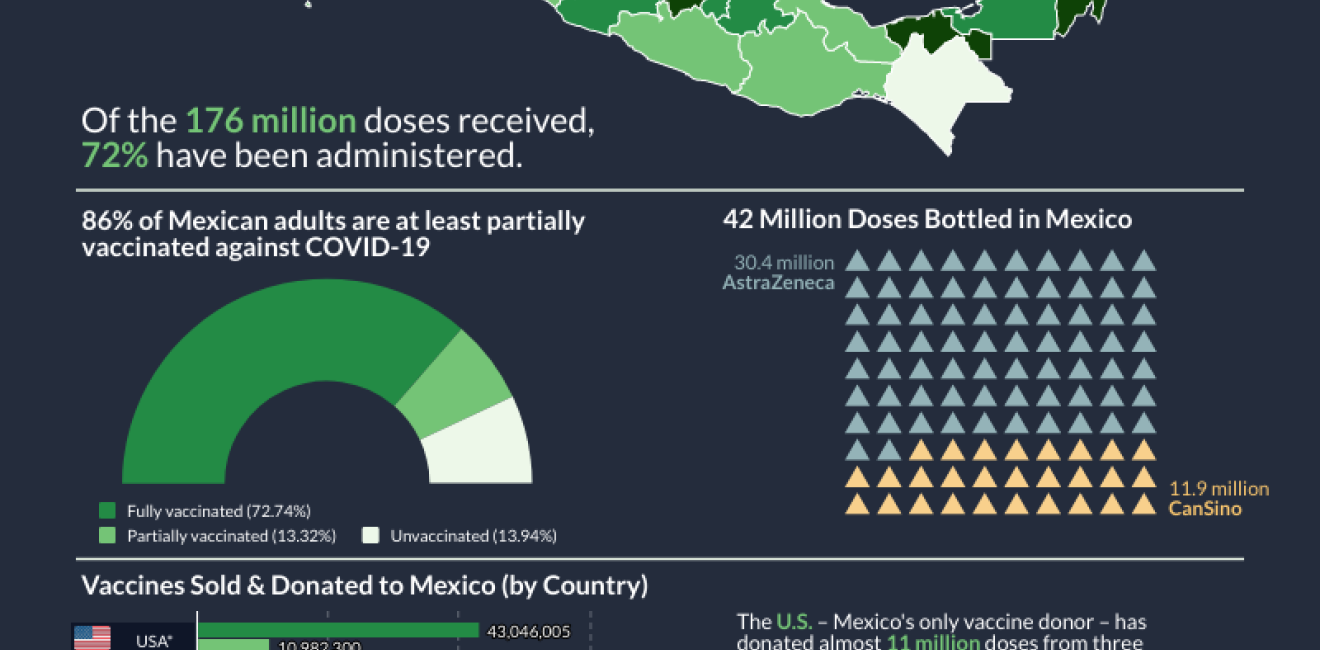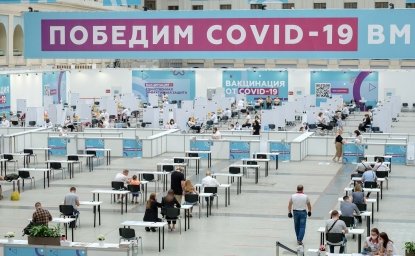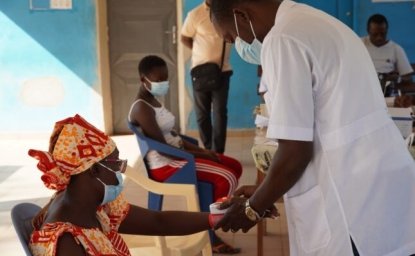<div class="piktowrapper-embed" style="height: 300px; position: relative;" data-uid="57089704-vaccination-progress-in-mexico"><div class="pikto-canvas-wrap"><div class="pikto-canvas"><div class="embed-loading-overlay" style="width: 100%; height: 100%; position: absolute; text-align: center;"><img width="60px" alt="Loading..." style="margin-top: 100px" src="https://create.piktochart.com/loading.gif"/><p style="margin: 0; padding: 0; font-family: Lato, Helvetica, Arial, sans-serif; font-weight: 600; font-size: 16px">Loading...</p></div></div></div></div><script>(function(d){var js, id="pikto-embed-js", ref=d.getElementsByTagName("script")[0];if (d.getElementById(id)) { return;}js=d.createElement("script"); js.id=id; js.async=true;js.src="https://create.piktochart.com/assets/embedding/embed.js";ref.parentNode.insertBefore(js, ref);}(document));</script>
By the end of September, Mexico had vaccinated 70% of its adult population (or 49% of its total population), a figure that rose a staggering 13% over the course of October. By October 29th, 2021, President López Obrador stated that “the commitment to apply at least one dose to all Mexicans, women and men 18 years or older, has been fulfilled.” At the time of the announcement, 83% of Mexican adults (or 58% of the total population) had received at least one dose to protect against COVID-19. Yet, Mexico’s adult vaccination rates slowed in November 2021. As of December 1st, 86% of Mexican adults have been vaccinated (reflecting a mere 3% increase from the end of October). While an important achievement, when taking into account the entire population, 40% remains unprotected against COVID-19.
Geographical Disparities
While the Mexican government has made great strides in distributing the available doses, underlying geographic disparities remain notable. In the early stages of Mexico’s National Vaccination Plan, northern states – important hubs for North America’s supply chains – had vaccinated significantly greater proportions of their populations relative to southern states, which generally tend to have weaker state capacity. Meanwhile, Mexico’s south had lagged behind its more lucrative counterparts in terms of vaccination, as well as in terms of state capacity, economic development, and civilian security.
The government’s inability to vaccinate southern states as efficiently or as early may exacerbate regional inequalities, especially as droves of migrants arrive at Mexico’s southern border and prepare for the trek northward. Indeed, Chiapas – the first Mexican stop for Central American migrants – has an adult vaccination rate of 61%, lagging well behind all other Mexican states, all of which have exceeded the 70% mark. While the end of November brought with it a reduction in north-south vaccination rate differences, these clearly remain.
Now, the highest vaccination rates country-wide are concentrated in economic powerhouses – like Nuevo León and Mexico State – and states where tourism contributes significantly to the local economies, like those in the California and Yucatán Peninsulas.
Vaccine Supply Chains
Mexico contracted 244 million vaccines from COVAX, AstraZeneca, Pfizer/BioNTech, CanSinoBIO, SinoPharm, and the Gamaleya Center (which produces the Sputnik V vaccine), but these were slow to arrive and slow to enter Mexican arms in the first half of 2021. COVAX shipments proved particularly troublesome for Mexico. The AMLO Administration contracted 51 million doses through the COVAX program as early as February 2021 yet has only received 5.6 million of those. AMLO did not disguise his dissatisfaction with the COVAX initiative, calling it “a painful and utter failure” during his address to the UN Security Council on November 9th, 2021.
As well, to overcome challenges with the supply of ready-to-jab doses, Mexico set up production lines in Querétaro and the México State to bottle doses of the AstraZeneca and CanSino vaccines, completing the production process in-country. Mexico has received a total of 42.3 million doses to bottle domestically, 28% of which are from CanSino and 72% from AstraZeneca.
These massive vaccine acquisitions significantly began to pay off in the last quarter of 2021. By the end of September 2021, Mexico had only received 109 million – or 45% – of the 243 million contracted doses, showcasing weaknesses in global vaccine production and supply levels. However, since October, supplies have arrived more expeditiously, increasing Mexico’s vaccine coffers to 142 million doses by the end of October (a 58% contract fulfillment rate), and, by the end of November, to 176 million (a 72% contract fulfillment rate).
Still, these sudden dose influxes have not translated to higher vaccination rates. While the Mexican government had consistently deployed about 85% of its COVID-19 vaccine arsenal in any given month prior to November, by the beginning of December, the figure had fallen to 72%. Between the government’s inability to swiftly distribute such a large surge in available doses and a dwindling unvaccinated yet eligible population, the incoming vaccines have expanded Mexico’s stockpiles – not its protection. In effect, Mexico has nearly 50 million COVID-19 doses sitting in storage.
Vaccine Diplomacy
While only one country – the United States – has donated vaccines to Mexico, seven countries have received Mexican vaccine donations. Mexico sent modest shipments in the hundred-thousands to Belize, Bolivia, Paraguay, Guatemala, Honduras, El Salvador, and Jamaica. In total, Mexico has donated 1.3 million AstraZeneca doses to friends in the region.
Meanwhile, only the United States has donated vaccines to Mexico. By October, the U.S. had delivered 7.6 million doses of the 8.5 million total that it pledged to Mexico. It fulfilled the pledge in late October with 2.5 million bonus doses, bringing the total of donated doses to 11 million – or 6% of Mexico’s total vaccine stockpiles. While the FDA has not approved the AstraZeneca vaccine for use in the U.S., that vaccine comprises 56% of the donations that have arrived in Mexico. The Moderna vaccine comprises 32% of donations and the Johnson&Johnson, 12%.
In March 2021, the United States had preemptively acquired millions of AstraZeneca vaccines and faced backlash from allies for stockpiling the unapproved doses instead of deploying them to support international vaccination efforts. As a result, the Biden Administration respectively “loaned” Mexico and Canada 2.5 million and 1.5 million AstraZeneca doses. For Mexico, this loan was discretely conditioned on restricting migration flows at its southern border with Guatemala. Now, in lieu of repaying the loan, Mexico and Canada will make further vaccine donations to other countries, as the Three Amigos agreed during the North American Leaders’ Summit in November.
Eligibility
In August, Sub-Secretary of Health Hugo López-Gatell said that children would not be included in the national immunization plan unless “a solid, and convincing but in a different manner, scientific element were to appear, then we would possibly consider an alternative path.”
The Mexican government has faced tremendous pressure – and multiple lawsuits – to find that alternative path for adolescents aged 12 to 17. In early October, the federal government expanded eligibility to members of this age group that suffer from chronic respiratory, cardiac, and immunological diseases or that are at risk of developing health complications due to teen pregnancy. It expected to vaccinate around a million qualifying adolescents, leaving adolescents in good health, which represent about a third of the total population, without access to protections against COVID-19. In response, families turned to the courts to obtain legal mandates that required the authorities to provide immunizations to adolescents, which the federal government promptly challenged. On November 19th, the government conceded to include healthy adolescents aged 15 to 17 in the National Vaccination Plan.
Ongoing efforts to vaccinate children younger than 15 face obstacles as senior government officials have repeatedly rejected the importance and relevance of including this sector of the population in the National Vaccination Plan. Secretary of Public Health Jorge Alcocer argued that children have "marvelous immune systems" that can evade the effects of COVID-19, while the vaccine could “hinder learning.” As a result, only children 12 and up with comorbidities, or 15 and up generally, can access the Pfizer-BioNtech jab – the only COVID-19 vaccine currently approved for minors.
During the December 7 daily morning conference, AMLO announced the third-dose rollout and proceeded to receive his own jab on stage. As the Omicron variant surges, the AMLO Administration has urged people over 60 and teachers to receive a booster shot. However, boosters – all of which will be AstraZeneca doses, regardless the vaccine applied for the initial jab(s) – were only initially available in six entities: Mexico City, Jalisco, Chiapas, Oaxaca, Sinaloa, and Yucatán. It is unclear when adults under sixty will be eligible for a third dose.
Separately, Mexico set conditions to approve the reinstatement of the Migrant Protection Protocols (MPP, better known as the “Remain in Mexico” policy), including demands for the U.S. to vaccinate migrants as they await asylum hearings and prior to being sent back to their home countries. The U.S. agreed to Mexico’s stipulations, and the MPP was reenacted on December 6.
Dose Data
On November 10, the National Institute for Information Access (INAI) ordered the government to publish more extensive, relevant vaccine data – an order that the government challenged in court. On December 3rd, Mexico's Supreme Court ruled in favor of the government to classify all COVID-19 vaccination information – from arrivals to manufacturer shipments to distribution details to dose numbers – as matters of national security. In particular, this court order will allow the government to withhold information about where each dose was applied or whether it is in storage.
Below you can download the PDF versions of each of this infographic's iterations, with data updated on September 28th, October 30th, and December 1st, 2021. For more on “vaccine diplomacy” in Latin America and its role in great power competition, visit the Latin America Program's portal.







